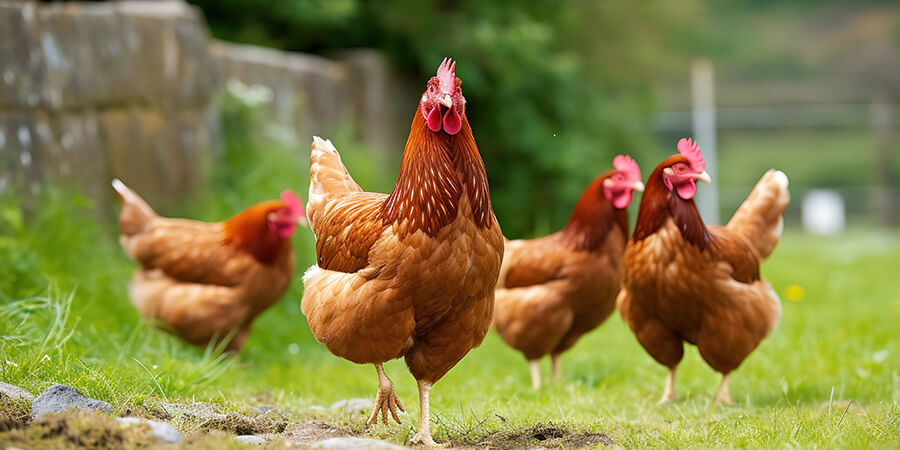1. Maintain a consistent temperature within the coop.
Firstly, it is essential to ventilate the breeding area at varying intervals according to specific stages throughout the day.
1. During the heating phase from 9:00 AM to 10:30 AM, gradually increase the ventilation rate.
2. In the high-temperature period around noon, adjust ventilation and temperature control appropriately based on climate conditions.
3. From 4:00 PM to 10:00 PM during the cooling phase, progressively decrease the ventilation rate.
4. Late at night until just before sunrise in the morning, maintain minimal ventilation as appropriate.
Particular attention should be paid to time-controlled ventilation. Monitor the body temperature of the chickens and avoid increasing ventilation when minimum ventilation suffices. If a combination of temperature control and time-controlled ventilation is used, the temperature control set point can be 2 to 2.5°C higher than the target temperature.
Ultimately, manage the coop temperature carefully. For the first two weeks, prioritize heat preservation while maintaining adequate ventilation. From the third week onward, gradually increase ventilation. After four weeks, ventilation should become the primary method.
2. Strictly prevent epidemic diseases, particularly Newcastle disease (ND), Avian Influenza (AI), Mycoplasma synoviae (MS), and Infectious Bronchitis (IB), through comprehensive prevention and control measures:
First, improve environmental conditions to interrupt disease transmission pathways.
Second, implement precise immunization protocols based on field conditions. Emphasize selection of vaccine strains, vaccine dilution ratios, dosages, vaccination methods, and antibody monitoring in chickens. In the event of an outbreak, adjust immunization schedules appropriately by advancing or delaying vaccinations as necessary.
3. Keep a good “disinfection gate” to cut off the infection of bacteria, strengthen disinfection, and leave no dead corners.
First, do a good job of isolating the source of the disease, flushing and disinfecting the chicken house, disinfecting items and vehicles, and managing the disinfection of people entering and leaving the bath; second, disinfection with chickens, choose less irritating and odorless disinfectants, and use different ingredients in turn. Generally 1 to 2 times a day. It should be noted that the disinfection effect is best at room temperature around 25°C, and the droplets of disinfectant spray should be fine, not spraying on the chickens to disinfect.
4. Keep a good “feeding gate” to ensure accurate nutrition supply.
After the chicks enter the house, they should drink water first and then eat. For chickens that are not good at foraging, artificial feeding should be used, especially for chickens transported over long distances, and the water lost by the body should be replenished in time. Feed less and add more frequently, and it is strictly forbidden to have residual feed in the feed trough. Large chicks can be grouped according to strength and weakness, and multivitamins and other anti-stress drugs should be given water before grouping. According to the different growth stages of broilers, daily diets should be prepared according to feeding standards.
5. Keep a good “health care gate” to prevent environmental diseases.
First, chickens should be introduced from healthy breeder farms to prevent pathogens from being introduced through vertical transmission; second, a good breeding environment should be created, including the large environment of the chicken farm and the small environment in the house; the principles of eliminating rodent pests, strictly preventing rodent pests from spreading diseases, burning and burying dead chickens, and isolating sick chickens from healthy chickens should be followed. Third, accurate and reasonable use of drugs. Strictly follow the requirements of antibiotic-free breeding, start with strengthening the immune function of chickens, focus on prevention, and choose antibiotic alternatives.
6. Keep a good “management pass” and implement practical operation plans.
First, personnel should be managed in a closed manner, and it is forbidden to eat poultry meat, eggs and poultry-related foods to prevent the introduction and spread of diseases; second, prevent chicken breast cysts. A layer of soft items can be added to the bottom of the cage to prevent the chicken breast from directly contacting the wire and causing breast cysts. Third, separate cage management. When separating cages, the upper layer should be placed first and the lower layer should be placed later. After separating cages, the temperature can be raised by 0.5-1°C due to the decrease in the stocking density. The adjustment range is based on the fact that there are still 10%-15% open-mouthed chickens after separating cages. Fourth, the lighting time should be shortened, not extended. Except for the first week, the chicken house must have more than 4 hours of light control time, and the light duration should be gradually extended 5 days before release.
